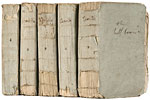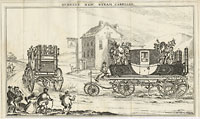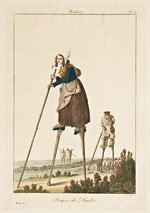June Brides
Austen Influence?
Works by Fanny Burney et al., Bloomsbury Auctions, New York, $14,400
“Samuel Johnson & Women Writers in Georgian England” was the theme of a fascinating, 500-lot collection of books, autograph letters, and pictures formed by the late Paula Peyraud of Chappaqua, New York, sold on May 6. It was thus no surprise to find a good many lots featuring the work of Fanny Burney.
Sold at $20,400 was a fine, 1778 first edition copy in contemporary calf of Burney’s first published work, Evelina, or a Young Lady’s Entrance into the World, which she once said was written in a night and in a disguised hand, in order to keep her identity from the publishers. Its immediate success, however, made it impossible for her to preserve the anonymity she desired.
The three volume first of Evelina, which in 1977 had sold for $1,540 at Sotheby’s New York, was in a contemporary calf binding with gilt tooled decoration, but a five-volume, 1796 first of Camilla, or, a Picture of Youth that sold for $6,600 was as issued in bluish-gray sugar paper wrappers. Uncut, and with considerable loss to the spines, it was at some stage marked “to be half bound” on the front covers of two of the volumes, but that never happened.
Very much in original condition, it bears the signature to each preliminary blank of the Duchess of Beaufort, who helped promote subscriptions to Fanny’s work, but the printed list of subscribers also contains the name of a certain Miss J. Austen of Steventon. Jane Austen read Camilla during the summer months of that year and soon thereafter began work on “First Impressions,” or Pride and Prejudice, as it finally emerged in 1813.
Peyraud’s copy of Pride and Prejudice, in contemporary dark green half-calf but lacking the half titles, sold at $31,200, and her copy of Sense & Sensibility, a fine-looking example in tan half-calf and marbled boards, was bid to $45,600.
Look Ma, No Horse!
1830 “Steam Carriage” Described, Bonhams, Oxford, $1,330
“Gurney’s New Steam Carriage,” the large folding engraved plate seen here, accompanies a little 1830 tract called Fairburn’s Account of the New Steam Coach, Invented by Mr Gurney, Constructed to Convey Six Inside and Fifteen Outside Passengers by Day or Night with the Greatest ease and Safety. Influenced by a meeting with another Cornishman, Richard Trevithick, who built the first working steam railway engine, Sir Goldsworthy Gurney built a steam-powered road vehicle himself in 1823, and six years later he travelled the 100 miles from Bath to London, and back again, at what is claimed to have been a sustained speed of 15 mph. The journey was not entirely without incident: There was a collision with the Bristol mail coach, and on one occasion this horseless carriage attracted the unwanted attentions of Luddites who were protesting the increasing industrialization of Britain.
Gurney’s plans for a regular passenger service using steam-driven road vehicles came to nothing, however, as the powerful operators of horse-drawn passenger transport joined forces to ensure that Gurney, and any others with similar ideas, were forced out of business. Part of an April 7 sale of the Enys family collection of Cornish books, pamphlets, prints, etc., Gurney’s tract sold at £900 ($1,330) to London dealers Quaritch.
Strange Shepherds
Curious Costumes of Bordeaux, Bloomsbury Auctions, New York, $4,800
The Ruffner costume book collection, sold on April 4, included a copy of Gustave de Galard’s Receuil des divers Costumes des habitans de Bordeaux et des environs, a small folio collection of 32 colored engraved plates issued in Bordeaux in 1818–19. Among its many attractions was this extraordinary image of “Bergère des Landes,” shepherds walking on stilts. Advertised by the saleroom as something not seen at auction in the last 30 years, the folio, in later morocco backed boards with the original wrappers bound in, duly sold at $4,800.
Why the stilts? Before it was transformed into forest, the region of southwest France known as Les Landes had been a desolate place, with practically no paths—a barren moorland that could turn to marshland in winter, when the rivers swelled and flooded. So the local shepherds used stilts to get around.








 Ian McKay’s weekly column in Antiques Trade Gazette has been running for more than 30 years.
Ian McKay’s weekly column in Antiques Trade Gazette has been running for more than 30 years.


